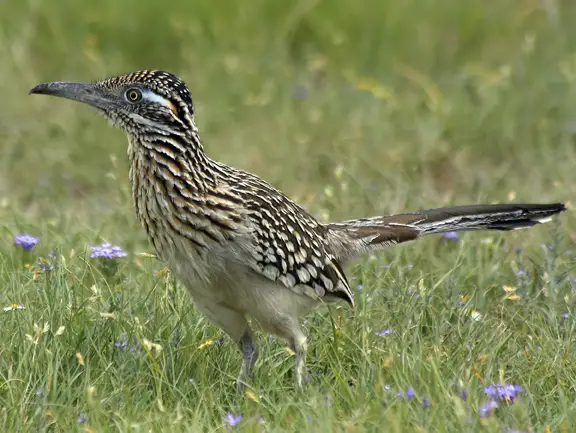The greater roadrunner (Geococcyx californianus) is one of the fastest birds on land. The bird’s body is not only built for the speed but can also survive on the harshest deserts. The ground-dwelling bird is found in the southwestern United States. Roadrunners are capable to hunt rattlesnakes and their speed is even more than that of humans. It is also called ‘ground cuckoo’.
Roadrunner Bird Facts
Anatomy
- Adult roadrunner grows up to 52–62 cm (20–24 in) in body length with a wingspan measuring up to 43–61 cm (17–24 in).
- The average weight of greater roadrunner is about 221–538 g (7.8–19.0 oz).
- Adult roadrunners stand 25–30 cm (9.8–11.8 in) tall. It is the America’s largest cuckoo.
- It is nearly the size of a Common Raven.
- The greater roadrunner is recognized by its long neck and legs with a tail that is fairly straight.
- There is a short crest over the head but the bill is quite heavy.
- Greater roadrunners have got tan and blackish plumage. They have got streaky brown feathers and tail which is help up while running.

Habitat & Range
- Greater roadrunners have adapted to live on the shrubby expanses of deserts where most other birds give up. They also make habitats in open country which especially which is abundant in small trees.
- They are found around the Mississippi River. Roadrunners also live in the Louisiana and Missouri.
- Roadrunners also occupy the semi-open habitats in the northern California. The greater roadrunner’s habitats include riparian woodlands, chaparral, tamarisk, canyons, and mesquite. Their habitats are found at an altitude of about 10,000 feet above sea level. They also make habitats below the sea level.
- At higher altitudes roadrunners prefer to choose sites such as cholla grasslands and pinyon-juniper woodlands.
- They are widely distributed throughout the United States including eastern Oklahoma, western Arkansas, and southwest Missouri.
- Roadrunners are less likely to occupy areas dominated by scrubby woods, hardwood stands, red juniper, and loblolly pine forests.
Behavior
- True to its name greater roadrunners spend many hours on the ground for a simple reason that they are extremely good runners.
- You don’t often see roadrunners perching on tree except on a fence post or a telephone wire.
- It is a highly territorial species and may drive off predators like lizards and large rodents.
- While they are regular runners they may nevertheless jump high enough to catch insects and small birds during flight.
- The greater roadrunner doesn’t seem to be comfortable during flight.
- During broad daylight hours they may take sunbath.
- They will also produce sounds like coo-cooo-coooo.
- Roadrunners are capable to eat even the poisonous of the prey such as scorpions and lizards.
- They are able to reach speeds of about 26 mph (42 km/h) on land. It is the fastest flying bird on land.
- They have got the ability to retake water from their feces. It really helps them to thrive in the dry arid habitats.
- During the bright sunlight they will seek shades.
Feeding Ecology & Diet
- The greater roadrunner is a carnivorous bird and it feeds on a wide variety of animals. This includes small mammals, insects, birds, reptiles, scorpions, toads, centipedes, and frogs. Insects include grasshoppers and beetles.
- They are also thought to consume carrion and bird eggs.
- Roadrunners are very familiar snake-eaters. Prominent among the snakes is a rattlesnake. The bird has got a way of killing larger prey that is to say it strikes the prey against a rock multiple times until the prey dies. The roadrunner then swallows the entire prey.
- During winter, roadrunners supplement their diet with some fruits and seeds. Plants only make up 10% of the bird’s diet.

Reproductive Biology
- The clutch size is 2 – 6 white eggs. Each year 1 – 2 broods are raised.
- Male roadrunner brings female all the necessary materials for building nests. The depth of the nest is about 4 inches with a diameter measuring up to 17 inches and a height of 8 inches.
- The nest is lined with materials such as feathers, leaves, snakeskin, and grasses.
- Both parents do not stop working on the nest even when the chicks are grown up. They will also build the sides of the nest. They may also use the same nesting site again the next year.
- They become mature at 2 years of age.
- Young birds will learn to fly 18 days after their birth.
- The incubation period lasts 19 – 20 days. Both parents incubate the eggs.
- The breeding interval is one year.
- The greater roadrunner’s eggs are 1.4–1.8 in (3.5–4.6 cm) long with the width averaging 1.1–1.3 in (2.8–3.3 cm).
- They will build nests 3 – 10 feet high into the trees. The nests are usually built on the branches of cactus.
- The maximum lifespan of a roadrunner is about 7 – 8 years.
Conservation Status
Least Concern






Leave a Reply